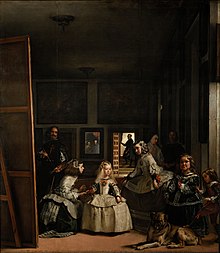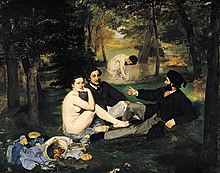Herman Braun-Vega
[8] Introduced by his brother to the poet Jean Sénac, he evolved as soon as he arrived in the Parisian artistic community in a privileged way as a resident of the Hôtel du Vieux-Colombier, then managed by Maria Manton and Louis Nallard.
In October 1952 his son Eric was born from a temporary affair with a young Frenchwoman, Camille Mülder, model of the photographer Albert Monier, who regularly frequented Saint-Germain-des-Prés.
Herman had to abandon painting and dedicate himself to interior design, working for Jean Royère on whose behalf he finds himself in charge of opening a decoration agency in Peru.
Young Herman Braun produced paintings that perfectly integrated the lessons of modern art and fed on some of its movements such as cubism (Still life with red wine bottle, 1949) or impressionism (Banana trees, 1951) that kept him away from any temptation for photorealism.
Thus it happened to him to give a voice to some of his characters (Adam and Eve, 1965; Encuentro en el campo, 1965), or to cut out his painting in boxes in the style of a comic strip in order to insert narrative content (The artist ans his model, 1968) In 1966, he made of his brother Max, the painter Fernando Vega who suddenly died in Ibiza at the age of 33 from a heroin overdose,[15] a heartbreaking portrait.
So that as soon as he returned to Paris, launching himself a challenge,[16] he produced, in two and a half months like Picasso (but without imitating him),[17] a series of fifty-three paintings entitled Velazquez laid bare accompanied by the Meninas.
It is a cinematic study ("a kind of cartoon")[18] with bright side lights and contrasted colors,[19] of the moments which supposedly preceded the placement of the characters in the pose of Velázquez's famous painting.
[22] Jean-Jacques Lévêque, in Les Nouvelles littéraires, sees it as proof “that a great future is still possible for the ‘painted surface’”[23] and hails, in Le Nouveau Journal, “an astonishing virtuosity in the perspective of layout and animation specific to narrative figuration”.
This is something that he will use a lot when he becomes Braun-Vega and which is undoubtedly related to the choice of the title Windows of art, soul and life by curator Christian Noorbeergen for the last exhibition organized during the artist's lifetime at the UNESCO Headquarters in Paris in 2018.
[38] In his series on The Turkish Bath, Braun analyses the plastic and aesthetic influences of Ingres' work in certain trends of contemporary art (geometric abstraction, hyper-realism).
There are also many first times in this series, which perhaps explains this comment from Picture on exhibit which salutes the "tour de force" represented by these variations around the Turkish bath ranging from the simple drawing to the use of the most diverse techniques.
[41] Since the dynamic begun in 1968 after the discovery of Picasso's Las Meninas, Braun has never stopped, while studying the great masters of painting, from experimenting with new techniques which each time increase his skills.
In this series whose cold and effective "à la Poussin" style is bathed in a warm chromatic, Braun takes an ironic look at our «culture of consumption» by inserting in trompe l'oeil everyday consumer objects.
Marie-Claude Volfin, for Les Nouvelles Littéraires, points out that «Unlike Equipo Cronica, who seeks to demystify the notion of a masterpiece, there is no parody in Herman Braun’s excellent work but a transfer of values».
These encounters work either by analogy as in Bonjour Monsieur Poussin where the presence of a tank in the streets of a city and The Rape of the Sabine Women by Poussin both represent military aggression against civilians, or by opposition as in Buenos dias Vermeer where the hushed universe of the Young woman with a water pitcher by Vermeer comes face to face with the atmosphere of a South American shanty town.
From 1981 onwards, the North and South cardinal points appear in some of his works, sometimes discreetly, as on the paper held in the hand of Pope Innocent X by Velasquez in the painting I love the neutron bomb,[57] or as in the painting Buenos dias Vermeer,[58] in the form of graffiti on the edge of the wall separating the universe of Vermeer from the Latin American world, sometimes in a much more obvious way with red letters as on the North-South drawing from the FRAC Normandie Caen collection,[59] or as on the drawings Le bain... after Ingres I[60] and Le bain... after Ingres II.
This is a possible key to reading some of his works, even if the latter do not explicitly show the North and South cardinal points, as it is the case with the painting The Cheaters (after de La Tour),[62] in which the servant in the painting The Card Sharp with the Ace of Diamonds by Georges de La Tour is replaced by a Peruvian peasant woman symbolizing the servitude of Third World countries to the rich countries, the cheaters around the table.
[65] In 1982, very temporarily putting aside his art of pictorial quotation to concentrate exclusively on the testimonial dimension of his work, he explored a new technique by which he produced a series of reliefs on paper entitled testimonio.
[69] The artistic production of Herman Braun, whose roots are now firmly defined, now develops on large format canvases (2m × 3m) for an exhibition entitled Paysages Mémoire at the Théâtre du Rond-Point in Paris in 1984.
Sensitive to Braun-Vega's ability to freely recreate the spirit of the artists with whom he nourishes his painting, critic Jean-Luc Chalumeau, who appreciates his "flamboyant unrealism", underlines the skill with which he plays with the grain of the unbleached canvas as if it was a color on its own right on his palette.
[72] Among these, we can mention Why not them ?,[73] an irreverent plea for the popularization of culture, where the Grande Odalisque by Ingres is offered to the curiosity of children[74] (collection of the museum of the city of Maubeuge) and The lesson.. .
[79] He surprises the viewer by putting Boucher's Diana Bathing in the presence of two naked mixed race people[80] and thus expresses, according to Julio Ramon Ribeyro, the emergence of a multiracial and multicultural world resulting from crossbreeding and syncretism.
[83] And this also does not exclude adding other messages as in this revival of Las Meninas of 1987 in which he replaced in the mirror of the back of the room, the reflections of the king and the queen, symbols in this place of the omnipresence of power, by the pope receiving Kurt Waldheim while holding in hand the newspaper Libération headlining on the condemnation of Klaus Barbie.
This painting entitled Double focus over the West[84] denounces the power of the Church to exonerate a former Nazi of his faults and at the same time represents the ethnic diversity existing in a country like France.
Nevertheless, Braun-Vega produced a series specially for the occasion entitled Peru-Spain: bare memories in which he is particularly interested in the consequences of this encounter, as brutal as it was, and in the ethnic and cultural mix that resulted from it.
[87] In the introduction text of the exhibition catalog, Federico Mayor, Director General of the UNESCO, underlines the effectiveness of the pictorial vehicle that are the works of Braun-Vega to awaken the consciences of Europe to the realities of Latin America.
[88] For the first time in this new series, there are references to the Peruvian chronicler Felipe Guamán Poma de Ayala, a half-breed who travelled throughout Peru to witness the living conditions of the indigenous people under Spanish rule.
He claims the duty of memory to avoid falling into barbarism, makes his painting a real means of knowledge and very conscientiously takes on his role as a teaching artist, going so far as to participate in student activities.
Commenting on his painting Músico en el mercado,[94] Braun-Vega said in the mid-1990s that he wanted to free himself from his usual references to Western iconography, retaining only the mixtures of style described by Jean-Luc Chalumeau.
[110] While the first is mainly accessible to cultured people who will recognize the references to the history of art, or be challenged by a feeling of déjà vu, the social and political memory is requested to anyone with the curiosity to decipher the press clippings transfers.







